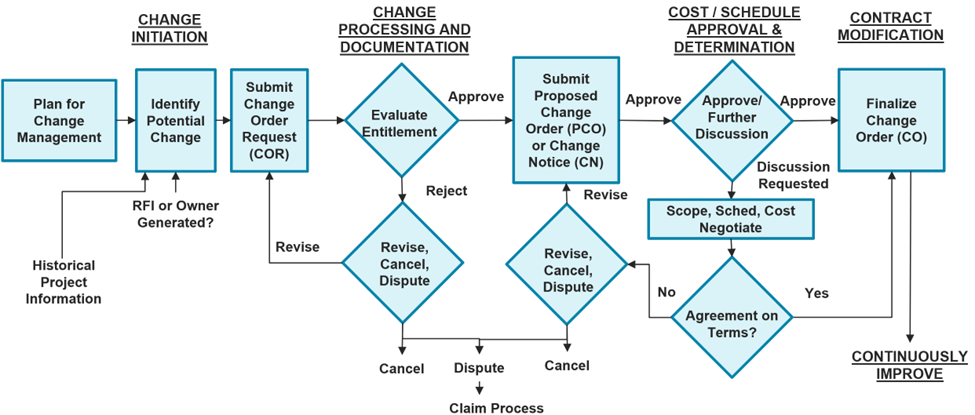Proactive Change Management in Construction Projects
Change is inevitable in every construction project. The key to success lies not in avoiding change, but in how effectively we identify, manage, and mitigate it. Proactive change management ensures projects stay on schedule and within budget while maintaining alignment with strategic objectives.
Why Proactive Change Management Matters
In the construction industry, scope changes can disrupt budgets, schedules, and stakeholder relationships. Early detection of potential changes and tracking emerging trends enables project teams to stay ahead of risks. Trends serve as the first warning signs of potential scope shifts, helping teams take corrective action before problems escalate.
Project vs. Program-Level Change Management
While the core principles … identifying, evaluating, approving, and implementing changes remain consistent, their application differs between project and program levels:
- Project-Level Change Management
Focuses on detailed, tactical activities such as issue tracking, cost and schedule analysis, and maintaining change order logs. - Program-Level Change Management
Operates at a higher, strategic level, ensuring alignment across multiple projects with governance boards, dashboards, and prioritization frameworks. This level emphasizes portfolio-level oversight, risk management, and adherence to funding or sequencing requirements.
In short: Project-level change management is tactical and contract-driven; program-level change management is strategic and governance-driven.
Change Management in Alternative Delivery Methods
Alternative delivery methods such as Design-Build (DB), Progressive Design-Build (PDB), and Construction Manager at Risk (CMAR) reshape the traditional change management process by involving contractors earlier in project development.
- Design-Build (DB): Integrated teams streamline scope evolution and decision-making.
- CMAR/CMGC: Collaboration occurs before the Guaranteed Maximum Price (GMP), then transitions to contractual control.
- Progressive Design-Build (PDB): Encourages joint ownership of change decisions, fostering transparency and collaboration.
Common Change Management Challenges
Effective change control requires visibility, fairness, and traceability. However, common pain points include:
- Budget and resource constraints
- Poor communication among stakeholders
- Misaligned objectives between project teams
- Weak governance and slow approval cycles
- Inadequate documentation and unclear accountability
The biggest challenge? Timeliness and transparency. When changes aren’t captured early or handled consistently, they lead to disputes, delays, and cost overruns.
A Structured Approach to Managing Change
Change management is the structured process of managing any deviation from the approved scope, cost, or schedule baseline. The goal is not to restrict change but to manage, mitigate, and document it.
A successful process typically includes five stages:
- Change Initiation – Identify potential changes early.
- Change Processing & Documentation – Record and categorize the change.
- Cost/Schedule Impact Analysis – Assess financial and timeline implications.
- Contract Modification – Approve and formalize the change.
- Lessons Learned & Continuous Improvement – Capture insights for future projects.

Key Takeaways: Building a Culture of Proactive Change
- Integrate Your Systems Early
Implement an integrated project management system early to generate data-driven insights. - Promote a “Change-Positive” Culture
Encourage teams to view early issue identification as a success, not a problem.
Emphasize no-surprise reporting and open communication. - Empower the Right Resources
Ensure estimators, schedulers, and cost engineers are engaged in design meetings to avoid bottlenecks. - Maintain Realistic Baselines and Contingencies
Track contingency drawdowns and treat them as leading indicators of potential overruns. - Engage Early and Often
Address issues in real-time—delayed action magnifies risk. - Leverage Trend Analysis
Use trend tracking as an early warning system to forecast potential changes and cost impacts. - Document Everything
Log and track all change requests, ensure approvals are in place before executing additional work, and maintain transparent documentation. - Capture Lessons Learned
Institutionalize continuous improvement by feeding lessons from one project into the next.
Change Management in Alternative Delivery
For collaborative models like Progressive Design-Build, proactive change management includes:
- Early identification of scope shifts during design milestones
- Risk and trend tracking via cost and schedule exposure logs
- Open-book cost sharing and collaborative decision-making
- Clear alignment between Owner Project Requirements and change processes
These strategies promote design-to-budget discipline through Target Value Design and progressive estimating, ensuring that value engineering is continuous … not reactive.
Field Perspectives: Collaboration in Action
Tim Buresch a webinar attendee from CSU emphasized the benefits of pull planning over traditional CPM scheduling to sustain project momentum and the use of global settlements to close out changes and ensure cost certainty.
Conclusion
Proactive change management is a cornerstone of successful project delivery. By integrating strong governance, data-driven insights, and early communication, teams can minimize the “iceberg effect” of hidden changes and ensure cost, schedule, and scope alignment from start to finish.
In construction, change is inevitable but proactive management turns it from a threat into an opportunity.
